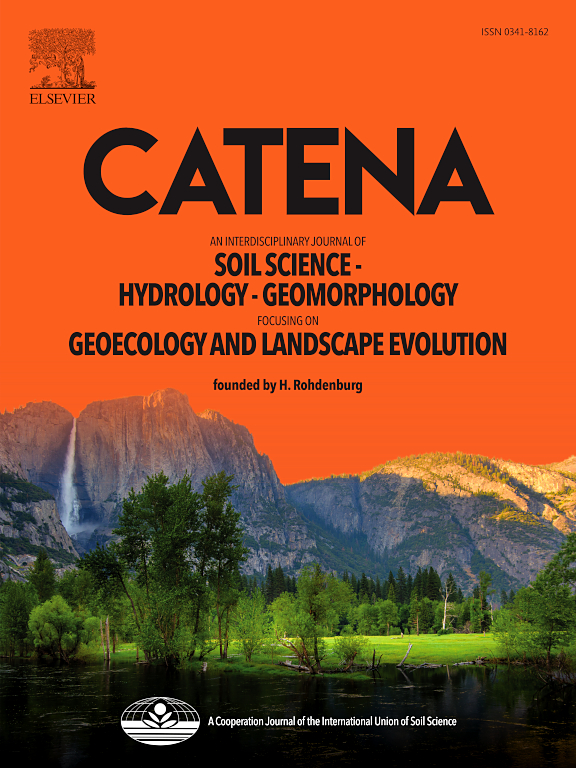由非有机石灰质形成的土壤及其对分类的人为影响,墨西哥特斯科科
IF 5.4
1区 农林科学
Q1 GEOSCIENCES, MULTIDISCIPLINARY
引用次数: 0
摘要
有机有机质(LM)形成的土壤文献记载甚多,但很少有研究考虑无机有机质,更不用说它们向土壤的演变。古特斯科科湖的人工干燥开始于一个多世纪以前,有利于含无定形火山物质和介形虫的高盐石灰岩沉积物上涌。正如Bockheim和Gennadiyev(2000)所指出的那样,目标是科学地分类由人类活动影响的非有机石灰物质形成的土壤,并根据其学名指定其土壤形成过程。原湖形成的土壤是复杂而非均匀的,每层有十多个成因特征;例如,同一视界可以命名为5BLtnqsez (ST)或5Ctnzcqgαβγλ (WRB)。ST显示了Entisols、Inceptisols、Andisols和Mollisols的形成。WRB指定了Solonchaks、Fluvisols、Regosols、Solonetz、Phaeozems、Calcisols、Anthrosols和Technosols的形成,最多有11个限定条件。土壤的形成过程主要有盐碱化、孤独化、硫化化、黑化、人类化、钙化、闪化和硫化等,其中大部分特征在WRB中都有体现。然而,尽管本研究为非有机有机质的土壤分类提供了有价值的信息,但分类系统中还需要进一步的后缀和标准来区分它们与其他诊断材料。本文章由计算机程序翻译,如有差异,请以英文原文为准。
Soils formed from non-organic limnic materials and the anthropic influence on their classification, Texcoco, Mexico
Soils formed from organic limnic materials (LM) are well documented, but few studies have considered inorganic LM, let alone their evolution into soils. The artificial drying of the ancient Lake Texcoco began more than a century ago, favoring the upwelling of hypersaline limnic sediments with amorphous volcanic materials and ostracods. The objectives are to scientifically classify soils formed from non-organic limnic materials that human activities have influenced and to designate their soil-forming processes according to their scientific names, as Bockheim and Gennadiyev (2000) have indicated. The soils formed in the former lake are complex and heterogeneous, with more than ten genetic characters per horizon; for example, the same horizon can be named 5BLtnqsez (ST) or 5Ctnzcqgαβγλ (WRB). The ST indicated the formation of Entisols, Inceptisols, Andisols, and Mollisols. The WRB designated the formation of Solonchaks, Fluvisols, Regosols, Solonetz, Phaeozems, Calcisols, Anthrosols, and Technosols with up to 11 qualifiers. Soil-forming processes are Salinization, Solonization, Solodization, Melanization, Anthrosolization, Calcification, Gleyization, and Sulphurization, and most of the characteristics are represented in the WRB. However, despite the valuable information provided by this study on the soil classification of non-organic limnic materials, further suffixes and criteria are required in the classification system to differentiate them from other diagnostic materials.
求助全文
通过发布文献求助,成功后即可免费获取论文全文。
去求助
来源期刊

Catena
环境科学-地球科学综合
CiteScore
10.50
自引率
9.70%
发文量
816
审稿时长
54 days
期刊介绍:
Catena publishes papers describing original field and laboratory investigations and reviews on geoecology and landscape evolution with emphasis on interdisciplinary aspects of soil science, hydrology and geomorphology. It aims to disseminate new knowledge and foster better understanding of the physical environment, of evolutionary sequences that have resulted in past and current landscapes, and of the natural processes that are likely to determine the fate of our terrestrial environment.
Papers within any one of the above topics are welcome provided they are of sufficiently wide interest and relevance.
 求助内容:
求助内容: 应助结果提醒方式:
应助结果提醒方式:


